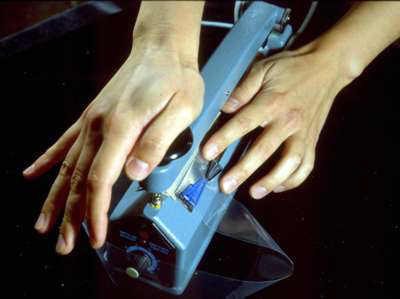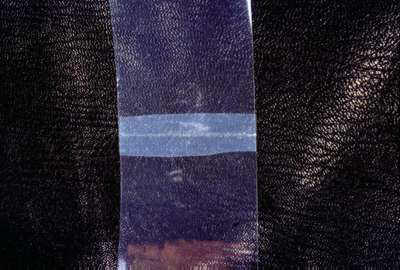

Attaching barcodes to heat-sealed polyethylene strap loops that wrap around a rare book's cover solves the problem of how to attach a barcode to an object without interfering with everyday use or doing any damage. The barcode does not become separated from the object as often happens when bags, card inserts or flags are used for the barcode. Wear on the spine is minimized since the book does not have to be opened to access the barcode. The polyethylene strap protects the integrity of decorative covers and other special bindings found in rare books.
How to Do It : Barcoding at the Folger
Shakespeare Library
In 1997 the Folger Shakespeare
Library was ready to begin placing barcodes on the rare books in their
collection. The library settled on the idea of using rings of
polyethylene strapping for the barcodes after rejecting other options
due to concerns for damage to the books or the potential loss of the
flags.
Originally presented by Linda A. Blaser as a poster at the AIC 28th Annual Meeting, June 8-13, 2000, Philadelphia, Pennsylvania. The full-length paper was published in the 2000 Edition of Book and Paper Annual of the American Institute of Conservators.
Supplies Needed: Thermo Impulse Sealer, 2-inch polyethylene strap, paper clips, scissors
Considerations: The polyethylene straps are quick and easy to make. There are some things to remember when making the loops. It is important to make the loop snug since loose loops tend to catch on things and stretch. It is also harder to slide books with the polyethylene straps into and out of tight bookshelves, so it is best to have some spare room on the shelf. Care should also be taken to adhere the barcode fully to the polyethylene strap without overlapping onto the cover of the book.
|
|
|
 Step 3.
Press down on the lever and briefly hold down. When the
red light goes out, release the lever. Step 3.
Press down on the lever and briefly hold down. When the
red light goes out, release the lever. |
|
 Step 5.
Carefully cut the strapping to include a half-inch
overlap. Step 5.
Carefully cut the strapping to include a half-inch
overlap. |
|
Abstract: Barcoding at the Folger Shakespeare Library
In 1997 the Folger Shakespeare Library had the computer technology in place and it was time to begin placing barcodes on the books. Several options were considered for rare books in our modern collection. Those options included placing barcodes on flags, adhering the barcodes inside the back cover, and adhering the barcodes directly to the back cover of the binding. We immediately dismissed the idea of adhering the barcodes directly to the back cover of any rare book with an original binding. Our curators were also very concerned with having the barcode on the endpaper. They felt that holding the covers open under the barcode reader would be awkward and would most likely jeopardize the integrity of the cover's hinges. We also discussed the idea of placing flags in the book but decided that they would easily be lost or placed in the wrong book. Then we considered adhering the bottom of the flag on the endpaper so that the top portion with the barcode stuck out beyond the cover. Since the flag would be adhered to the endpaper, the flag could not be separated from the book. We decided that the top of the cover would form a pivot point where the top of the flag would repeatedly fold until it finally broke off, separating the barcode from the book. Then I came up with an idea to use polyethylene strapping. The strapping is formed into a ring and slid onto the back cover. The barcode is adhered to that strap. The system has been successfully in use for the past four years. Not a single strap has been lost or broken and not a single barcode has needed to be replaced. Details about this system and about the discussions are included in the full-length paper.
In 1997 the Folger Shakespeare Library was ready to begin barcoding its modern book collection. Before the process began, discussions were held to determine which method we would use. After several meetings we had a plan, and the barcoding began. At this time we remain satisfied with the results.
Our modern book collection consists of books printed after 1800. As one can imagine the collection includes many styles of bindings in various conditions. We had already decided to allow readers to swipe their own barcodes when signing out books. Since many different people were going to be handling the books, we wanted to minimize damage due to handling. We worried about putting barcodes on the inside of the covers on the pastedowns. We felt that opening the covers to swipe the barcode would cause weak cover joints to give way, quickly. We also briefly discussed putting the barcodes on flags. It was pointed out that loose flags are often separated from their books, and it would not be easy to match them back up or to replace missing barcode flags. We had also discussed adhering the flag to the inside of the cover using wheat starch paste. This presented another problem: the flag would eventually begin to fold and then tear along the edge of the textblock or the cover. In the end we were certain putting the barcodes on the outside was the only way to go. The barcodes would be placed on the lower back cover.
Once that decision was made we needed to consider how the barcodes themselves might mar special bindings and how they could affect the future conservation of leather-bound and other specially bound items in our modern book collection. We also wanted to consider the aging aspects of the barcodes. I did a short heat-aging experiment to determine how barcodes survived with and without a barcode protector. As it turned out the barcode protector quickly darkened, shrank, and generally deteriorated. The barcode itself survived quite well, with little distortion or discoloring. We decided to leave the barcode protectors off. The librarians, curators, and other reading room staff were concerned about having barcodes adhered directly to special bindings, such as publisher's bindings. I was also concerned that the placement of the barcodes on the books' covers would affect future conservation treatments such as rebacking. The barcode itself is very stiff and hard, so it would be nearly impossible to neatly lift an old covering material to a insert a new rebacking material. We discussed putting chosen books in a Mylar cover with the barcode adhered to the Mylar. Since the books are all different sizes and the Mylar would have to be shaped to each book individually, this idea proved to be too time consuming. Finally, I thought of the polyethylene strapping we use to hold books onto cradles during exhibitions. I proposed we form a loop of polyethylene around the back cover of these chosen books and adhere the barcode to the polyethylene strap. While not flawless, this method has served us well for the past three years. All of the original polyethylene straps are still in place.